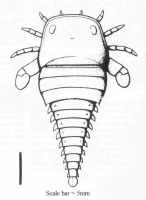|
A New Fossil Discovery At Achanarras
Quarry
by Jack Saxon
A paper has been published in the Scottish Journal of
Geology describing a new fossil of a very rare group discovered at
Achanarras Quarry in Caithness.
The new fossil is a chasmataspid and is closely related
to the eurypterids. These creatures resemble large aquatic scorpions and
were probably top predators in the Devonian Period, some 370 million years
ago. Fossil eurypterids have been known from Caithness for about two
centuries, mostly fragmentary. My son Roger and I collected one from John
O'Groats many years ago. In life it would have measured about a metre in
length. It is now in the Royal Museum in Edinburgh. A cast of this
creature can be seen in Shelleys museum in the Orcadian Stone Co., in
Golspie.
The new arthropod (a name given to joint-legged
creatures such as crabs and lobsters) is quite small by comparison with
the monster from John O'Groats, but is much rarer.
It has been called Achanarraspis reedi, after its
discoverer, John Reed of Rousay, Orkney, who sadly did not realise its
significance. This is the first one ever found in the Old Red Sandstone of
the Orcadian Basin. Achanarras needs no description since it is world
famous for its very large number of genera and species of fossil fishes.
This new creature resembles the Lower Devonian
chasmataspids from Germany and the Midland Valley of Scotland. Its Middle
Devonian age makes it the youngest chasmataspid yet known and
significantly extends the known range of the group.
Ref A Middle Devonian chasmataspid arthropod from
Achanarras Quarry, Caithness, Scotland. Anderson, L.l., Dunlop,J.A., and
Trewin,N.H. Scottish Journal of Geology, 36,(2), 151-158, 2000.
 Reconstruction
of Reconstruction
of
Achanarras reedi gen. et sp. nov. in dorsal view.
Appendages and some carapace details based on
comparisons with other Devonian chasmataspids.
Click To Enlarge
|